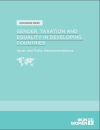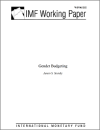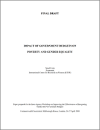Since the start of the COVID-19 pandemic, almost USD 16 trillion has been pumped into the global economy, and governments are now rolling out second and third ph
FOUND 25
Paper discussing the definition and measurement of Sustainable Development Goal (SDG) Indicator 5.c.1. (reclassified to Tier II) and comparing Indicator 5.c.1 with other SDG fiscal indicators.
Discussion paper examining the gender impact of personal, corporate and consumption taxes and proposing alternative tax policies to promote gender equality.
This IMF Working Paper examines how public processes can contribute to improving women's status. Gender budgeting, which refers to the systematic examination of budget programs and policies for their impact on women, has been tried in a range of countries in recent years.
The paper reviews the literature on the gender dimensions of taxation and the implications for tax policy with special reference to developing countries. It was commissioned by the Commonwealth Secretariat as part of the organization's commitment to integrate gender concerns into economic policy.
This resource pack authored by Debbie Budlender provides relevant knowledge to facilitate mainstreaming gender-responsive approaches into reproductive health programmes, and the inclusion of specific aspects of gender inequality and disadvantage into national policy frameworks.
The Health Rights of Women Assessment Instrument (HeRWAI) is a tool developed by the Humanist Committee on Human Rights (HOM) in 2006 to enhance lobbying activities for better implementation of women's health rights.
This paper provides guidance on how to make Public Finance Management (PFM) reforms gender responsive. It presents an overview of PFM reforms and explains how and why they are important to the achievement of gender equality outcomes.
In this paper, Simel Esim (2000) focuses on expenditure and revenue instruments of fiscal policy as strategic entry points for engendering macroeconomics. The paper also includes a discussion of the potential implications of monetary policy and overall fiscal stance on poverty and gender equality.
This paper by Simel Esim (2000) explores the revenue side of gender budgeting. Esim also discusses policies and suggests strategies for gender-sensitive budgeting.







